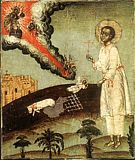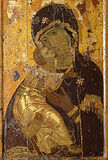 Meeting of the Vladimir Icon of the Most Holy Theotokos (1480).
Meeting of the Vladimir Icon of the Most Holy Theotokos (1480).  Martyr Agrippina of Rome and her companions Paula, Bassa, and Agathonica (253-259).
Martyr Agrippina of Rome and her companions Paula, Bassa, and Agathonica (253-259).  Synaxis of the Saints of Vladimir.
Synaxis of the Saints of Vladimir.
Martyrs Eustochius, Gaius, Proba, Lollia, and Urban, of Ancyra (4th c.). Second translation of the relics of St. Herman, archbishop of Kazan (1714). St. Artemius of Verkola (1545). Translation of the relics of St. Michael of Klops Monastery (Novgorod), fool-for-Christ (1482). St. Dionysius of Polotsk (1182). Sts. Joseph, founder (1612), Anthony, and Ioannicius, abbots, of Zaonikiev Monastery, Vologda (17th c.).
New Hieromartyrs Alexander Miropolsky, archpriest, of Kaslinsky Zavod (Ekaterinburg) (1918). New Hieromartyrs Mitrophan (Krasnopolsky), archbishop of Astrakhan (1919), and Leontius (von Vimpfen), bishop of Enotaeva (1919).
Icons of the Most Holy Theotokos: “Umileniye” (“Of Tender Feeling”) of Pskov (1524), and “Zaonikiev.” (1588)
St. Etheldreda, foundress of Ely Monastery (England) (679). St. Nicetas of Thebes in Boetia and his disciples Theodore, Gregory, and Daniel (1079). Hieromartyrs Aristocleus, priest, Demetrian, deacon, and Athanasius, reader, at Salamis on Cyprus (306). Synaxis of the New Martyrs of Crete (1821-1822).
Repose of Schemamonk Zosimas of Solovki (1855) and Ivan M. Kontzevitch, spiritual writer (1965).
Friday. [I Cor. 4:5-8; Matt. 13:44-54]
Arriving in Nazareth the Lord found no
faith there. His visible simplicity hindered the Nazarenes
from seeing His invisible glory and divinity. Does not the
same occur with a Christian? Christian dogmas are very
simple in appearance; but for the mind which enters into
them, they represent an all-embracing harmonious system in
and of themselves, which were not, nor ever could be
generated by any creature’s mind. Proud-mindedness,
casting a fleeting glance at the simplicity of the
Gospels, is repelled by it and begins to build its own
house of knowledge, which it deems enormous and full of
broad horizons. It is in fact no more than a towering
house of cards, and the horizons are no more than mirages,
phantom products of a heated imagination. But there is no
point in telling him. He and his brothers are ready with
their critical attacks to immediately cast anyone from the
mountain into the abyss who tries to dissuade them; but
the truth always passes unharmed through their midst and
goes on to other souls capable of receiving it.
Saturday. [Rom. 9:1-5; Matt. 9:18-26]
The woman with the issue of blood said:
If I may but touch His garment, (the Lord’s),
I shall be whole, and she received healing
according to her faith. We, the sensual, need physical
contact in order to receive intangible strength. The Lord
arranged things this way. His holy Church has a visible
structure. Its various parts embrace us and we touch them.
The power of God, found inside the Church, is received
through such contact by those who have a
receiver—faith, which says: “If I may but
touch, I shall be made whole.” The Church is the
body and garment of the Lord. The most visible parts,
which we touch, are the Divine Mysteries, particularly
baptism and Chrismation, the Sacrament of the Lord’s
Body and Blood in conjunction with the Sacrament of
confession. But contact with all the other aspects can
draw needed strength from the Lord, Who is everywhere. He
sees each person who does this, and says to his heart,
“Be bold, my child!” Free-thinkers,
antagonistic toward the external rites of the Church, thus
deprive themselves of the opportunity to enter into
contact with the inner, divine, all-animating power. This
is why they remain sick, and exhausting themselves with
the flow of vain thoughts and feelings, they dry up
spiritually and die.


![]() Meeting of the Vladimir Icon of the Most Holy Theotokos (1480).
Meeting of the Vladimir Icon of the Most Holy Theotokos (1480). ![]() Martyr Agrippina of Rome and her companions Paula, Bassa, and Agathonica (253-259).
Martyr Agrippina of Rome and her companions Paula, Bassa, and Agathonica (253-259). ![]() Synaxis of the Saints of Vladimir.
Synaxis of the Saints of Vladimir. 

















